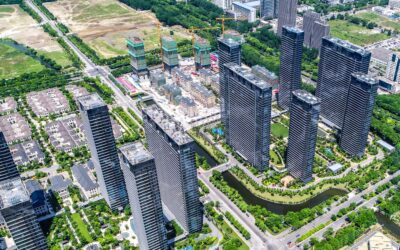Investing in Multi-Family Properties is considered to be one of the most lucrative real estate investments amongst realtors. Whether you are a novice or a veteran investor, if you’re looking for the best type of real estate investment in 2019, you should consider multi-family properties.
Here are a few things you should know before investing in Multi-Family Properties. But before that, here’s a little overview of what a multi-family property is and how these investments work. Skip to #1 factor you should consider if you’re acquainted with the basics. And for the beginners – here are some basics.
What are multi-family properties?
Residential properties with four or more units as different segments, making it possible for more than one family to reside in are called as multi-family properties.
If you’ve had a fair share of experience in dealing with single-family Properties and want to up your game of real estate investing one notch high, multi-family properties could be your best bet.
How does multi-family investing work?
There are not many differences between single-family property investing and multi-family investing. The framework remains the same – you look for properties on sale, narrow down your options, talk to a couple of sellers, take a tour of the property and talk about your concerns to the property owner, negotiate on the sale price, find the most relevant commercial real estate lender who’ll perfect your financing needs, buy the property, advertise or market your property to find potential tenants and rent out the space.
Quite similar to single-family properties management so far, right? The only significant difference, however, is about managing more units which means more tenants and finding the right mix of tenants to occupy your multi-family property.
You might also be needed to provide more facilities to your tenants like good Wi-Fi, laundry facilities, proper waste management, recreational areas and the like as you’re renting out your property to multiple families and thus, tenants expect more community-like facilities in the property.
Another difference that keeps some investors away from investing in Multi-family Properties is the management of different tenants and their needs, which might be cumbersome sometimes.
For that reason, there are several competent asset management companies out there to whom you can outsource the task of tenant and Property management altogether.
So, if managing more than one tenant sounds like a pain to you, remember that you can always explore asset management companies who’ll make your task simple and easy.
However, note that you don’t end up overspending here, so you don’t jeopardize your overall Return on Investment on your multi-family investing venture. That’s about the basics. Read on to know about the things you should know before investing in Multi-family Properties in 2019.
Things you should know before investing in Multi-family Properties
#1 – The condition of the property
The state of your property should be one of the first things you must look into while finalizing what features to buy. As a buyer, you must be informed about the defects in the property and have an idea about how many extra dollars you’d be required to shell out on repairs and renovations, over and above the purchase price of the property.
The basic things to look for during the inspection of the property are – the painting, the landscaping, interiors of the building, parking areas, and the like.
These are the first things any potential tenant would be looking at to rent out your space. The next set of things which you must look for from a buyer’s perspective would be – age of the building, the electrical and heating system of the building, the quality of materials used in the construction and the like.
Remember that these second set of things you must look for may not be so important for your tenants, but as a buyer, these could turn out to be huge expenses on a later date, should things go wrong.
Upgrading properties on such lines will require a huge amount of money, and acquiring newer loans to fulfill the same is quite a big burden. The older the property, the higher you’ll be spending on the property in the long run.
Thus, as a rule of thumb – it’s always safer to invest in newer multi-family Properties over their older counterparts. However, some old properties may have high intrinsic value due to the antiquity of the building. Such properties are an exception to this thumb rule.
#2 – Location of the property
The next thing to look at would be the location of the property. The location of the property determines a great deal about tenant occupancy rates and property vacancy rates.
Even the best of the properties in some cases have a hard time acquiring more tenants due to the location. Now, what’s a good location for the property? It depends.
It depends on the kind of tenant mix you’re looking, if you want to rent out your property to families, a good property location would be a neighborhood with schools, hospitals, shopping malls, restaurants, theatres and other amenities that families which are likely to be comprised of middle-aged parents and younger children will be looking.
On the other hand, if you wish to rent out your property to the senior crowd of the spectrum, a more serene neighborhood with parks, libraries, restaurants is more preferable.
So, based on the kind of tenant mix you wish to have, you should determine what’s a good location for you to invest in Multi-family Properties. Remember that different kinds of tenant mixes will have a different set of pros and cons.
For instance, while senior masses of the population might indicate a more stable crowd to pay rent on time due to their retirement and pension plans, the downside would be sudden health problems which may mean an immediate vacancy.
Likewise, with younger families, there might not be stability in terms of month-on-month rent recovery as these families have got children to raise and take care of, they are more probable to stay for longer periods of time due to committed jobs and education of children.
Over and above the tenant mix, you should also look into the overall neighborhood crime rates, the mix of properties in the neighborhood, and the condition of the surrounding environment. Remember that tenants are not looking for a good property but also a good neighborhood.
So, having a great property in a street that’s filled with destructed or bad properties might not be a great idea. As a general rule – look for a location that is most likely to be liked by you’d a potential mix of tenants.
#3 – Cash flow and lease calculations
You need to estimate and draw a projected cash flow statement based on how much return on investment you’ll be making. This is very important because, at the end of the day, it all comes down to how much profit you’ve made from your real estate investing. With multi-family properties, one major thing to consider is the lease expenses.
With different types of leases, it can be arduous to narrow down the best kind of lease which makes the most sense for your property and one that your seller stands by too. In a general scenario, properties that have month-to-month leases are less lucrative than the annual lease plans.
However, if you want to make repairs and renovations to your property and upgrade it, a month-to-month lease would be preferred as you can get started with your renovation work sooner.
While preparing your projected cash flow statement, consider the worst-case scenario where you may not have any tenant occupying your multi-family property and weigh what percentage of such loss can your home loan absorb.
Only after you’ve made a clear estimation and it’s still a win-win for you, you should go ahead with the property. Consulting a real estate expert is the best advice we can provide you minimize your probable losses and keep you from making poor decisions.
#4 – New Property construction
In some cases, building a new multi-family property might be the best answer. It removes all the other factors tied with buying a constructed property like leases, condition of the property, repairs, and renovations, and so on.
With a property you newly construct, you can have ultimate control over the quality of the construction and can rest assured about occupancy if you make a wise and informed decision with regards to the location of the property.
The best way to do this might be to source a commercial bridge loan to secure the property, complete all the building activity, and buy time to find potential tenants for your property. Remember that newly constructed properties always have a good selling proposition and can be very lucrative in terms of rental income.
However, on the downside, as the owner and the builder, you’ll have to go through the entire building process – from sourcing the right building materials, finding the right builders and contractors, to the legal paperwork. It can be tedious, but sometimes, there’s just nothing like building a new property. It is quite an experience.
If you’ve got the time and the will to construct a new multi-family property, zeroing down on the best location – it can work wonders for you.
These are four key factors you should consider before investing in a multi-family property. Regardless of whether you’re buying a built property or decide to build a new property, finding the right kind of commercial real estate loan is very important, and this decision can determine a great deal about your overall investing success! Explore our blog section and learn all about choosing the right kind of real estate loan for every financing need.





